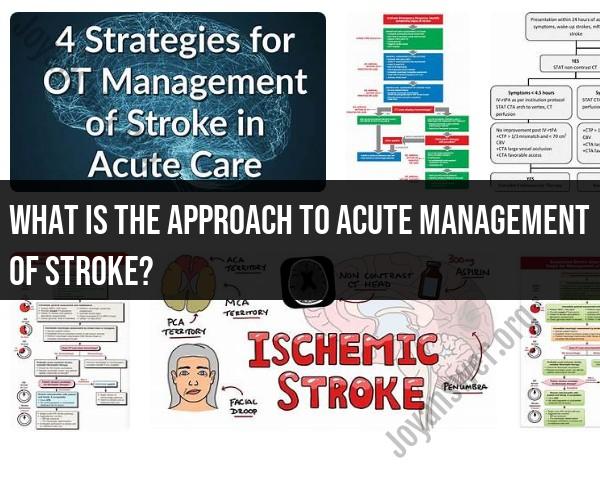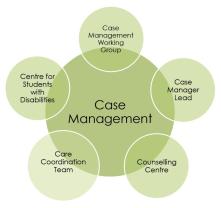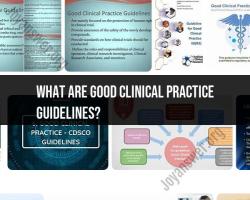What is the approach to acute management of stroke?
The acute management of stroke is a time-sensitive and critical medical emergency that involves various steps to minimize brain damage and improve outcomes. Here is an approach to the acute management of stroke:
Recognition of Stroke Signs and Symptoms:
- It's crucial to recognize the signs and symptoms of a stroke, which can include sudden numbness or weakness in the face, arm, or leg, especially on one side of the body; sudden confusion, trouble speaking, or difficulty understanding speech; sudden trouble seeing in one or both eyes; sudden trouble walking, dizziness, loss of balance, or lack of coordination; and a sudden severe headache with no known cause. These are often summarized using the acronym FAST: Face, Arm, Speech, Time to call 911.
Call Emergency Services (911):
- If you suspect that you or someone else is experiencing a stroke, call 911 immediately. Time is of the essence in stroke management, and getting medical help quickly is critical.
Emergency Evaluation and Transport:
- Emergency medical services (EMS) will perform an evaluation, including assessing vital signs and neurological symptoms. They will transport the person to the nearest appropriate medical facility with stroke capabilities.
Stroke Center or Primary Stroke Center:
- Whenever possible, transport the individual to a designated stroke center or primary stroke center, as these facilities are equipped to provide specialized care and treatments for stroke patients.
Evaluation and Diagnosis:
- In the hospital, the healthcare team will conduct a detailed evaluation and diagnostic workup, including a neurological examination, brain imaging (usually with a CT scan) to determine if the stroke is ischemic or hemorrhagic, and blood tests to assess important parameters.
Thrombolytic Therapy (If Applicable):
- If the stroke is caused by a blood clot (ischemic stroke) and the individual arrives within the appropriate time window, thrombolytic therapy with a medication like tissue plasminogen activator (tPA) may be administered to dissolve the clot and restore blood flow to the brain.
Endovascular Therapy (If Applicable):
- In some cases, particularly for larger clots, endovascular therapy may be performed. This involves using a catheter to remove or break up the clot directly.
Stroke Unit or Intensive Care:
- Stroke patients are often admitted to a specialized stroke unit or intensive care unit for close monitoring and specialized care.
Blood Pressure Management:
- Blood pressure may need to be controlled, depending on the individual's specific condition and vital signs.
Rehabilitation and Supportive Care:
- Stroke survivors often require rehabilitation services, which may include physical therapy, occupational therapy, and speech therapy to regain lost function. Supportive care and education for the individual and their family are essential.
Secondary Prevention:
- After the acute phase, it's crucial to address the underlying risk factors and provide appropriate medical management to prevent future strokes. This may include lifestyle modifications, medication management (e.g., antiplatelets, anticoagulants, statins), and addressing risk factors like high blood pressure, diabetes, and smoking.
Long-Term Follow-Up:
- Regular follow-up with healthcare providers is essential to monitor progress, adjust treatments, and ensure ongoing stroke prevention.
The approach to acute stroke management involves rapid recognition, immediate medical attention, and the administration of appropriate treatments, which can vary based on the type of stroke and the individual's specific condition. Time is a critical factor in stroke management, and early intervention can significantly improve outcomes and minimize long-term disability.
The Acute Management Approach for Stroke Patients
The acute management approach for stroke patients is focused on minimizing brain damage and maximizing the patient's chances of recovery. This involves:
- Rapidly identifying and diagnosing stroke
- Initiating appropriate treatment as soon as possible
- Providing supportive care and preventing complications
- Developing a plan for rehabilitation and recovery
Early Response to Stroke Symptoms: The FAST Method
The FAST method is a quick and easy way to remember the signs of a stroke. If you or someone you know experiences any of the following symptoms, it is important to call 911 immediately:
- Facial drooping: One side of the face droops or becomes numb.
- Arm weakness: One arm becomes weak or numb.
- Speech difficulty: Slurred speech or difficulty understanding.
- Time to act: If you notice any of these signs, call 911 immediately.
Stroke Assessment and Diagnosis in the Acute Phase
Once the patient arrives at the hospital, they will be assessed by a team of healthcare professionals, including a neurologist. The assessment will involve a physical examination, blood tests, and imaging tests such as a CT scan or MRI.
The imaging tests are used to determine the type of stroke and the location of the brain injury. This information is essential for developing the best treatment plan.
Acute Stroke Treatment: Thrombolysis and Thrombectomy
The two main types of acute stroke treatment are thrombolysis and thrombectomy.
- Thrombolysis is a medication that can be administered intravenously to dissolve blood clots. It is most effective when given within 4.5 hours of the onset of stroke symptoms.
- Thrombectomy is a minimally invasive procedure that can be used to remove blood clots from large arteries in the brain. It is most effective when given within 6-8 hours of the onset of stroke symptoms.
Post-Stroke Care and Recovery Planning
After receiving acute stroke treatment, the patient will be admitted to the hospital for further monitoring and care. The goal of post-stroke care is to prevent complications, promote recovery, and help the patient achieve the highest possible level of independence.
The patient's recovery plan will be tailored to their individual needs and may include:
- Physical therapy
- Occupational therapy
- Speech therapy
- Medication management
- Support groups and counseling
Conclusion
The acute management of stroke patients is essential for minimizing brain damage and maximizing the patient's chances of recovery. Early response to stroke symptoms is crucial, as the sooner treatment is initiated, the better the outcome.
If you or someone you know experiences any signs of a stroke, call 911 immediately.













